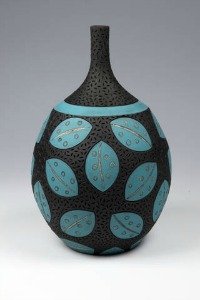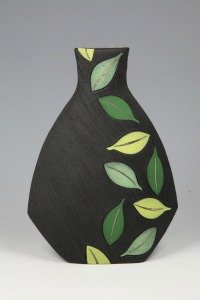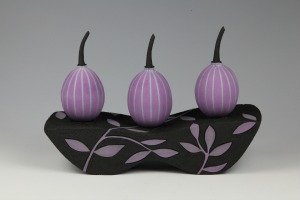Interview with Jacqui Atkin - Ceramic Artist
In this interview Jacqui Atkin reveals intimate details about her process with clay, her beginnings in pottery, her favorite ceramic techniques and the future of her ceramic work.
Jacqui is author of several great books on pottery making, including one of my favorite books 250 Tips, Techniques, and Trade Secrets for Potters.The interview includes her insightful perspective about process, growth as an artist, new directions, and her favorite quick and easy technique.
Ceramic Background, Process, New Directions
Steve: Jacqui, you are well known for your unique technique of combining textures and botanical imagery. What about your technique excites you the most?

Jacqui: All my life, from being a very little girl, I have enjoyed making patterns. In primary school we were given squared paper that allowed me to make repeat patterns and I could spend hours creating new designs. So, I guess I have just continued the obsession through my life but with clay I can work three dimensionally and introduce other elements like texture to the picture. I really only see my work as a surface to decorate and love the challenge of designing new forms simply because it will provide another surface to play with.
My studio is in my garden which is situated on the edge of woodland. The view from my window is of trees and birds, flowers and various little creatures scurrying by – dreamy really, I am very blessed to be able to work in such a place. The point I am trying to make is that these are the things that inspire me – nature in all its glory – the rough and the smooth, the rich pattern and texture of the trees against a clear blue sky, the vivid colour of Frank the pheasant as he wanders over the gravel outside my door.
There is constant movement of one surface against another and this is what excites me most and is what I try to capture in my work so that for instance, a vessel with vividly coloured falling leaves may be surrounded by scored lines which represent the swirling breeze as it blows the leaves – it gives the work movement and tells of what I have seen- tells a story almost.
Steve: How did you first become interested in working with clay?

Jacqui: When my youngest daughter went to school I started a Foundation course in art and design at City College in Manchester with a view to doing a degree in Interior design. Of course, you are introduced to all kinds of wonderful subjects at foundation level and I was in my element, especially enjoying textiles and printing but as soon as I got into the ceramic studio I knew I was hooked. All ideas of Interior design went immediately out of the window and the rest is history as they say!
Steve: What is the first clay piece you remember creating?
Jacqui: I remember very clearly, the first thing I made in clay and in fact still have it in my studio. My tutor trained in product design before becoming a ceramics tutor so was very design focused and our first project was to build a form from identically shaped and sized slab sections which interlocked in some way. It was a very abstract introduction to clay – not at all what I had expected but I instantly loved the challenge of making the clay behave as I wanted it to and I was back in school – making up repeat patterns but in a three dimensional way.
Contrary to many of the other students, it didn’t matter to me that what I was making had no function. I realise now that I learned much about clay from that one simple exercise. What a clever tutor!
Steve: What is it about your chosen medium that challenges you?
Jacqui: I have recently changed my style after burnishing and smoke or resist raku firing for many years. The challenge has been to take elements from the old style and make it into something new. So I decided that what I liked about raku was the combination of a smooth surface and pattern next to smoked black texture. What I didn’t like (apart from the fact that it was making me ill) was the fact that the smoky firing process tends to subdue colour. So my challenge was to find a way of encompassing all these things to create a new body of work without the damaging effects of smoke inhalation and I discovered that I can get the results I like with more dynamic colour contrasts using Velvet underglaze colours.
However, the greatest challenge when changing style is being accepted by ‘the establishment’. It is often frowned upon to change course but I am of the opinion that we shouldn’t stand still. We should constantly stretch ourselves, our work should move on and we should challenge ourselves constantly to create something new – be true to our creative selves.

Steve: What advice would you offer to a beginner who is just learning to work with clay?
Jacqui: I think to be a successful potter you have to have a certain level of obsession about it. Many of my friends tell me I am driven in my approach to my work and I suspect most potters who make their living this way would confess to being the same. So, to someone just starting out I would suggest that they practice to perfect their techniques and find a style of their own. Don’t be put off by early failures, these are important, you should learn from them and everyone makes them at first. Read and research ways of doing things – this will help you to find your own way of doing things because we all interpret things differently and there is never just one way. Learn the basics well, it will be a good ground from which to develop your own style – and realise that the rules are there to be broken or at least manipulated but you can only do this with knowledge.
Clay is a fantastic, all consuming, constantly exciting medium in which to work – if you feel like this - you will become a good potter!
Steve: Can you share with us a tip or technique that you wish you had learned earlier in your career?
Jacqui: I am a very meticulous worker – a bit anal some might say or possibly borderline OCD ish! When I was at college my tutor used to say ‘you are allowed to make a mess you know Jacqui’ and I struggled with this as all around me other students spread themselves out getting clay everywhere, losing their tools so helping themselves to other peoples. I liked to work in a clean and ordered space with my own tools at hand and to tidy up as I went along. I think I felt guilty that I wasn’t more like the others but I just couldn’t work that way. Now I realise that it was right that I should have been challenged about it but that it is also very important to be true to yourself. I need to feel calm when I’m working, and I only feel calm in a tidy environment - others don’t feel the same - the truth is it doesn’t matter.
So that is my tip for those people just starting out – find your best way of working and don’t be mislead into thinking it is wrong - it is your way and part of your identity as a maker.
My books are full of great tips for working practice but I think using a toothbrush to replace scoring and slipping is one of the best and is a great time saver.
<<< Check out her book!
This will become an indispensable resource for your studio.
Steve: In what direction do you see yourself taking your work in the future?
Jacqui:I am currently in the process of setting up a new company making drinking vessels using the same imagery as on my main body of work and on wall panels that I have been making for many years – which show generic bird forms and use botanical samples from the garden.
My main body of work will develop slowly as it always has – It will take me a while to be fully satisfied with my new style of working, I have not resolved certain issues yet – it is always work in progress – and always should be I think.
I have just finished a new edition of my first book ‘Hand built pottery techniques revealed’ which will be out in the spring. It is an extended edition with a new section of ideas for shape and form, another project and a gallery of inspirational works by established potters. It will be available from my website through Amazon when published.
Also, I am working on a new book of ceramic problems and answers but don’t have a publishing date yet but it will be published on my website when I have it.
My next show is the ‘Hand and wheel ceramics festival’ and will be on Sunday September 30th - 10am to 5 pm @ Ashton Court Mansion, Ashton Court estate, Long Ashton, Bristol BS41 9JN.
See more of Jacqui's work at her web site www.jacquiatkin.com
On behalf of myself and all of the readers here at Pottery-on-the-Wheel.com thank you for sharing your insights and inspirations about the world of ceramics with us.
Jacqui's books share the same thoroughness and meticulous attention to detail that is evident in her work. They are excellent resources for any studio.
Where to Next?
Learn How This Website Got StartedWatch Pottery Throwing Videos
Share Your Photos
Add YOUR 2 Cents







New! Comments
Have your say about what you just read! Leave me a comment in the box below.